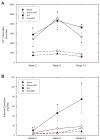Endothelin A receptor blockade reduces diabetic renal injury via an anti-inflammatory mechanism
- PMID: 17167119
- PMCID: PMC2579758
- DOI: 10.1681/ASN.2006030208
Endothelin A receptor blockade reduces diabetic renal injury via an anti-inflammatory mechanism
Abstract
Endothelin (ET) receptor blockade delays the progression of diabetic nephropathy; however, the mechanism of this protection is unknown. Therefore, the aim of this study was to test the hypothesis that ET(A) receptor blockade attenuates superoxide production and inflammation in the kidney of diabetic rats. Diabetes was induced by streptozotocin (diabetic rats with partial insulin replacement to maintain modest hyperglycemia [HG]), and sham rats received vehicle treatments. Some rats also received the ETA antagonist ABT-627 (sham+ABT and HG+ABT; 5 mg/kg per d; n = 8 to 10/group). During the 10-wk study, urinary microalbumin was increased in HG rats, and this effect was prevented by ET(A) receptor blockade. Indices of oxidative stress, urinary excretion of thiobarbituric acid reactive substances, 8-hydroxy--deoxyguanosine, and H2O2 and plasma thiobarbituric acid reactive substances were significantly greater in HG rats than in sham rats. These effects were not prevented by ABT-627. In addition, renal cortical expression of 8-hydroxy--deoxyguanosine and NADPH oxidase subunits was not different between HG and HG+ABT rats. ETA receptor blockade attenuated increases in macrophage infiltration and urinary excretion of TGF-beta and prostaglandin E2 metabolites in HG rats. Although ABT-627 did not alleviate oxidative stress in HG rats, inflammation and production of inflammatory mediators were reduced in association with prevention of microalbuminuria. These observations indicate that ETA receptor activation mediates renal inflammation and TGF-beta production in diabetes and are consistent with the postulate that ETA blockade slows progression of diabetic nephropathy via an anti-inflammatory mechanism.
Figures







Similar articles
-
Distinct actions of endothelin A-selective versus combined endothelin A/B receptor antagonists in early diabetic kidney disease.J Pharmacol Exp Ther. 2011 Jul;338(1):263-70. doi: 10.1124/jpet.111.178988. Epub 2011 Apr 6. J Pharmacol Exp Ther. 2011. PMID: 21471190 Free PMC article.
-
Combined endothelin a blockade and chlorthalidone treatment in a rat model of metabolic syndrome.J Pharmacol Exp Ther. 2014 Nov;351(2):467-73. doi: 10.1124/jpet.114.215566. Epub 2014 Sep 4. J Pharmacol Exp Ther. 2014. PMID: 25189702 Free PMC article.
-
Endothelin a receptor blockade and endothelin B receptor blockade improve hypokalemic nephropathy by different mechanisms.J Am Soc Nephrol. 2003 Feb;14(2):397-406. doi: 10.1097/01.asn.0000046062.85721.ac. J Am Soc Nephrol. 2003. PMID: 12538740
-
Endothelin receptor A-specific stimulation of glomerular inflammation and injury in a streptozotocin-induced rat model of diabetes.Diabetologia. 2011 Apr;54(4):979-88. doi: 10.1007/s00125-010-2021-4. Epub 2010 Dec 30. Diabetologia. 2011. PMID: 21191784 Free PMC article.
-
Endothelin antagonists for diabetic and non-diabetic chronic kidney disease.Br J Clin Pharmacol. 2013 Oct;76(4):573-9. doi: 10.1111/bcp.12064. Br J Clin Pharmacol. 2013. PMID: 23228194 Free PMC article. Review.
Cited by
-
Protective effects of miR-29a on diabetic glomerular dysfunction by modulation of DKK1/Wnt/β-catenin signaling.Sci Rep. 2016 Jul 27;6:30575. doi: 10.1038/srep30575. Sci Rep. 2016. PMID: 27460630 Free PMC article.
-
Urinary biomarkers in lupus nephritis.J Transl Autoimmun. 2020 Feb 13;3:100042. doi: 10.1016/j.jtauto.2020.100042. eCollection 2020. J Transl Autoimmun. 2020. PMID: 32743523 Free PMC article. Review.
-
Sex differences in TLR4 expression in SHR do not contribute to sex differences in blood pressure or the renal T cell profile.Am J Physiol Regul Integr Comp Physiol. 2022 Apr 1;322(4):R319-R325. doi: 10.1152/ajpregu.00237.2021. Epub 2022 Feb 2. Am J Physiol Regul Integr Comp Physiol. 2022. PMID: 35107023 Free PMC article. Clinical Trial.
-
Rosiglitazone decreases blood pressure and renal injury in a female mouse model of systemic lupus erythematosus.Am J Physiol Regul Integr Comp Physiol. 2009 Apr;296(4):R1282-9. doi: 10.1152/ajpregu.90992.2008. Epub 2009 Feb 4. Am J Physiol Regul Integr Comp Physiol. 2009. PMID: 19193937 Free PMC article.
-
Avosentan reduces albumin excretion in diabetics with macroalbuminuria.J Am Soc Nephrol. 2009 Mar;20(3):655-64. doi: 10.1681/ASN.2008050482. Epub 2009 Jan 14. J Am Soc Nephrol. 2009. PMID: 19144760 Free PMC article. Clinical Trial.
References
-
- Ding SS, Qiu C, Hess P, Xi JF, Zheng N, Clozel M. Chronic endothelin receptor blockade prevents both early hyperfiltration and late overt diabetic nephropathy in the rat. J Cardiovasc Pharmacol. 2003;42:48–54. - PubMed
-
- Cosenzi A, Bernobich E, Trevisan R, Milutinovic N, Borri A, Bellini G. Nephroprotective effect of bosentan in diabetic rats. J Cardiovasc Pharmacol. 2003;42:752–756. - PubMed
-
- Hocher B, Schwarz A, Reinbacher D, Jacobi J, Lun A, Priem F, Bauer C, Neumayer HH, Raschack M. Effects of endothelin receptor antagonists on the progression of diabetic nephropathy. Nephron. 2001;87:161–169. - PubMed
-
- Gomez-Garre D, Ruiz-Ortega M, Ortego M, Largo R, Lopez-Armada MJ, Plaza JJ, Gonzalez E, Egido J. Effects and interactions of endothelin-1 and angiotensin II on matrix protein expression and synthesis and mesangial cell growth. Hypertension. 1996;27:885–892. - PubMed
-
- Sorokin A, Kohan DE. Physiology and pathology of endothelin-1 in renal mesangium. Am J Physiol Renal Physiol. 2003;285:F579–F589. - PubMed
Publication types
MeSH terms
Substances
Grants and funding
LinkOut - more resources
Full Text Sources
Other Literature Sources
Medical

